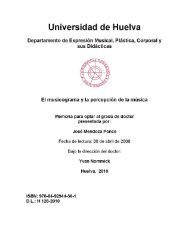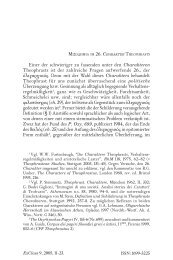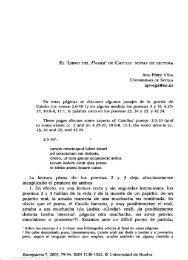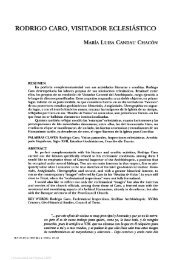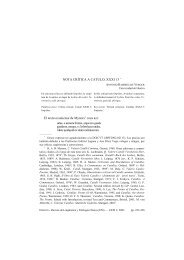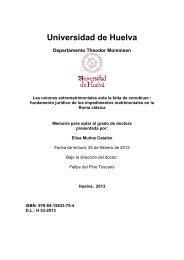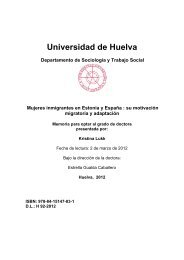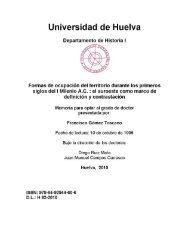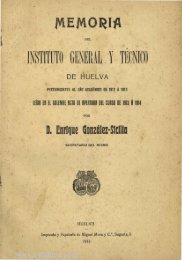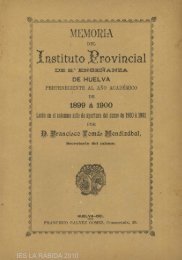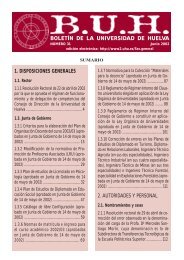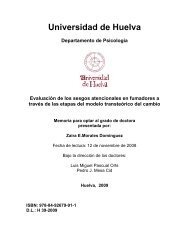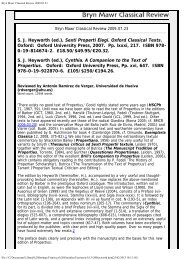- Page 1:
Universidad de Huelva Departamento
- Page 4 and 5:
Índice
- Page 6 and 7:
6.2. Estructuras de participación
- Page 8:
vi Índice de Figuras Figura 4.1. D
- Page 11 and 12:
La velocidad con la que se desarrol
- Page 13 and 14:
numerosos instrumentos de comunicac
- Page 15 and 16:
Por otro lado, el 90% de profesores
- Page 17 and 18:
esultados hacen referencia a contex
- Page 19 and 20:
conversación- promueven procesos d
- Page 21 and 22:
telemática más utilizada en este
- Page 23 and 24:
Un punto de vista interesante recon
- Page 26:
PARTE TEÓRICA
- Page 29 and 30:
1.1. Aprendizaje y conocimiento en
- Page 31 and 32:
educativos, durante muchos años fu
- Page 33 and 34:
naturaleza transcultural por lo que
- Page 35 and 36:
1.2. Cultura, educación y desarrol
- Page 37 and 38:
del individuo pasa a formar parte d
- Page 39 and 40:
hacen posible. El tipo más simple
- Page 41 and 42:
problemas a través de instrumentos
- Page 43 and 44:
• La naturaleza social de la cogn
- Page 45 and 46:
intersubjetividad proporciona el fu
- Page 47 and 48:
los participantes ocurren parcialme
- Page 49 and 50:
intersubjetividad. En sentido contr
- Page 51 and 52:
colaboración hace referencia a dos
- Page 53 and 54:
individual que aporta la sociedad y
- Page 55 and 56:
lenguaje como medio para construir
- Page 57 and 58:
1.3. Implicaciones de la teoría so
- Page 59 and 60:
mejorar el grado de intersubjetivid
- Page 61 and 62:
compartida del conocimiento de prof
- Page 63 and 64:
analizamos el pensamiento como acti
- Page 65 and 66:
marco de referencia dentro del cual
- Page 67 and 68:
“actividad” representaría los
- Page 69 and 70:
desaparece tan pronto como se produ
- Page 71 and 72:
actividad y la información necesar
- Page 73 and 74:
• Tratamiento diferencial de dete
- Page 75 and 76:
Por otro lado, Stodolsky (1991) den
- Page 77 and 78:
aula virtual hemos utilizado cierto
- Page 79 and 80:
2.1. Introducción Encontramos en l
- Page 81 and 82:
estructura organizativa y de gesti
- Page 83 and 84:
En la lista de los inconvenientes t
- Page 85 and 86:
encuentra desatendida por los circu
- Page 87 and 88:
tipo general, dirigidas a todos los
- Page 89 and 90:
EAD, encontramos precisamente en fu
- Page 91 and 92:
• La instrucción didáctica o de
- Page 93 and 94:
En la EAD han abundado los modelos
- Page 95 and 96:
fundamental del pensamiento al impo
- Page 97 and 98:
nuevo invento se convierte en la so
- Page 99 and 100:
• Inmaterialidad: Ofrecen la posi
- Page 101 and 102:
sin ordenador a un 10%, cuando es u
- Page 103 and 104:
Estas tendencias señaladas por Col
- Page 105 and 106:
conexiones por línea telefónica d
- Page 107 and 108:
desarrollaban, mostrándose inflexi
- Page 109 and 110:
por la reactiva o semi-interactiva,
- Page 111 and 112:
Tiempo Realidad Uso de medios TABLA
- Page 113 and 114:
de profesores y alumnos desde el pu
- Page 115 and 116:
Aprendizaje Enseñanza a distancia
- Page 117 and 118:
de acción en la comunicación entr
- Page 119 and 120:
función también a través de turn
- Page 121 and 122:
esencial facilitar sistemas de comu
- Page 123 and 124:
miembros de los que no lo son y de
- Page 125 and 126:
TIPO EMISOR Cap. II. Enseñanza a D
- Page 127 and 128:
orden comunicativo y pedagógico. E
- Page 130 and 131:
Capítulo III: El discurso en el au
- Page 132 and 133:
electrónicos en relación con un t
- Page 134 and 135:
Por un lado, existe un enfoque ment
- Page 136 and 137:
implicación, implicatura convencio
- Page 138 and 139:
Searle (1980) desarrolló la teorí
- Page 140 and 141:
la comprensión de la conversación
- Page 142 and 143:
3.2. Algunos elementos relevantes p
- Page 144 and 145:
Estas consideraciones implican que
- Page 146 and 147:
Los cambios de turno en la conversa
- Page 148 and 149:
Pero, además del contexto físico
- Page 150 and 151:
3.3. Distintas aproximaciones teór
- Page 152 and 153:
Desde los años 70, los lingüistas
- Page 154 and 155:
(pragmático). Las personas utiliza
- Page 156 and 157:
que participen individual y públic
- Page 158 and 159:
Por lo tanto, según Edwards y Merc
- Page 160 and 161:
144 4. Resumir 5. Definir 6. Adapta
- Page 162 and 163:
intercambios ya que no siempre se u
- Page 164 and 165:
• Estudios sobre colaboración en
- Page 166 and 167:
Las investigaciones que se realizar
- Page 168 and 169:
ejemplo que el humor entre docentes
- Page 170 and 171:
el que las palabras puedan ‘desen
- Page 172 and 173:
Para Gallimore y Tharp (1990) el le
- Page 174 and 175:
En relación con los aspectos morfo
- Page 176 and 177:
peso para argumentar que, en la pr
- Page 178:
encontramos discursos orales, como
- Page 182 and 183:
Capítulo IV: Metodología
- Page 184 and 185:
su función es simplemente la de fa
- Page 186 and 187:
profesores y estudiantes en program
- Page 188 and 189:
espondieron a las necesidades de lo
- Page 190 and 191:
La forma de llevar a cabo el proces
- Page 192 and 193:
que contamos con seis participantes
- Page 194 and 195:
que permitieran la posterior recons
- Page 196 and 197:
En cualquier caso y, gracias a las
- Page 198 and 199:
180 Tipos de cadenas de Mensajes De
- Page 200 and 201:
descubrirlos es a través del estud
- Page 202 and 203:
Primero se realizó un acercamiento
- Page 204 and 205:
conjunto. Es necesario, pues, que i
- Page 206 and 207:
Presentamos los datos analizados, o
- Page 208 and 209:
Capítulo V: Características de la
- Page 210 and 211:
incomprensiones. En el correo elect
- Page 212 and 213:
Cabecera 194 Figura 5.1. Un ejemplo
- Page 214 and 215:
Saludo Cada medio de comunicación
- Page 216 and 217:
198 ***JOSE*** ******** ** * * ****
- Page 218 and 219:
ordenador, novedoso para todos. Rec
- Page 220 and 221:
Como en cualquier comunicación, en
- Page 222 and 223:
El mantener este sistema de titulac
- Page 224 and 225:
los intercambios conversacionales,
- Page 226 and 227:
208 por JBG, eliminando del mensaje
- Page 228 and 229:
210 Figura 5.5. Ejemplo de mensaje
- Page 230 and 231:
derivadas de un alargamiento exager
- Page 232 and 233:
En estos mensajes se observa como u
- Page 234 and 235:
el primer bloque, que responde a la
- Page 236 and 237:
diseño gráfico, combinación de o
- Page 238 and 239:
220 :-) alegre :-( triste TABLA 5.4
- Page 240 and 241:
Otro aspecto relevante desde el pun
- Page 242 and 243:
comparar este tipo de comunicación
- Page 244 and 245:
E incluso podemos observar en el si
- Page 246 and 247:
Los alumnos de un sistema de formac
- Page 248 and 249:
230 [...] (1) Alu:JCQ> Desde Arzua,
- Page 250 and 251:
232 [...] (8) 'Crea con WP un fiche
- Page 252 and 253:
234 [...] (16) Alu:JCP> Poñome a f
- Page 254 and 255:
236 - "Nombre de portada": Podes ig
- Page 256 and 257:
comunicaban sólo a través del cor
- Page 258 and 259:
en la expresión. En el programa de
- Page 260 and 261:
242 (37) [...] Alu:JCP> Significa e
- Page 262 and 263:
En este sistema de teleformación,
- Page 264 and 265:
Siguiendo a Van Dijk (1983) en su c
- Page 266 and 267:
248 Alu:RFM> caso. Me explico, yo e
- Page 268 and 269:
necesario delimitar al espacio de a
- Page 270 and 271:
intercambios se realizan dos a dos,
- Page 272 and 273:
Entendiendo que cada mensaje tiene
- Page 274 and 275:
social no sea muy formal) cierta co
- Page 276 and 277:
De todas maneras, la forma de parti
- Page 278 and 279:
En la actividad colaborativa se sig
- Page 280 and 281:
262 ALU:JCQ> Te escribo para que me
- Page 282 and 283:
264 MSG. 2 [...] (11) Prf:JBG> Creo
- Page 284 and 285:
se hace referencia. Esto no benefic
- Page 286 and 287:
informáticas requiere de una gran
- Page 288 and 289:
telegráfico (23), ya que la cuesti
- Page 290 and 291:
272 (28) Alu:LFD> 1ª. Duda: ¿que
- Page 292 and 293:
nuevos elementos. Ni siquiera para
- Page 294 and 295:
Como ejemplo observemos la siguient
- Page 296 and 297:
La explicación más plausible esta
- Page 298 and 299:
280 (8) Prf:JBG> Por si la pregunta
- Page 300 and 301:
La asincronía representa un buen n
- Page 302:
pública, suponiendo que muchas de
- Page 305 and 306:
6.1. Estructura de la actividad aca
- Page 307 and 308:
del módulo ENT. Aunque cada una de
- Page 309 and 310:
(como ocurriría en un aula presenc
- Page 311 and 312:
Num Mensajes Num Me nsajes Num Mens
- Page 313 and 314:
subestructuras que se caracterizan
- Page 315 and 316:
dependen tanto la programación de
- Page 317 and 318:
Cap. VI. Estructura del Aula Virtua
- Page 319 and 320:
Pero existen otras combinaciones en
- Page 321 and 322:
de ENT03 a ENT06 (SI de Valoración
- Page 323 and 324:
(1) Alu:JCQ> [...]2º- Quisiera que
- Page 325 and 326:
----------8 Vaivos chegar un: X2_F1
- Page 327 and 328:
(3) Prf:FVB> O anterior se empregas
- Page 329 and 330:
como objetivo que puedan alcanzar l
- Page 331 and 332:
[..] (2) Prf:FVB> Do Y2_B1LD3.TXT r
- Page 333 and 334:
Un alumno -JCQ- envía un fichero c
- Page 335 and 336:
información sobre el funcionamient
- Page 337 and 338:
Prf:FVB> * SOLUCION * Prf:FVB>.- Ir
- Page 339 and 340:
RFM> vez el texto de write sin dibu
- Page 341 and 342:
Alu:JCQ> recibir críticas. Por pon
- Page 343 and 344:
Prf:JBG> ¿Tan buenos somos FVB y y
- Page 345 and 346:
[...] (51) Alu:JCQ> Envioche o exer
- Page 347 and 348:
evaluación de las tareas. Estas va
- Page 349 and 350:
pregunta" • Por último, le muest
- Page 351 and 352:
MSG 2/7 [...] (65) Prf:JBG> O punto
- Page 353 and 354:
6.1.3. Aprendizaje colaborativo y a
- Page 355 and 356:
Num Mensajes 100 80 60 40 20 0 Evol
- Page 357 and 358:
desarrollada por dos estudiantes en
- Page 359 and 360:
actividad y el resto del grupo. Al
- Page 361 and 362:
Como ya hemos observado en la Figur
- Page 363 and 364:
la marcha general de la actividad q
- Page 365 and 366:
[...] (6) Alu:RFM> Eso es todo y pe
- Page 367 and 368:
manifiesta una comprensión del des
- Page 369 and 370:
compañero porqué considera releva
- Page 371 and 372:
MSG 4/4 [...] Alu:LFD>[...]Cuando p
- Page 373 and 374:
La información que comparten no s
- Page 375 and 376:
Alu:JCP> año o dos, pero si tú no
- Page 377 and 378:
[...] (43) Alu:RFM> dBase IV no per
- Page 379 and 380:
6.1.4. Tutoría entre iguales Otra
- Page 381 and 382:
comentarios insertados inmediatamen
- Page 383 and 384:
[...] (19) Alu:RFM> ¿Cómo se deli
- Page 385 and 386:
cabo sus actividades académicas si
- Page 387 and 388:
Esta preocupación manifestada por
- Page 389 and 390:
sienten conformes con la respuesta.
- Page 391 and 392:
Todo ello es señal de un aumento d
- Page 393 and 394:
Ref:_OCU_9407 200.MSG Alu:JCP a Alu
- Page 395 and 396:
En resumen, podemos señalar que la
- Page 397 and 398:
al diálogo desarrollado en la conv
- Page 399 and 400:
en el aula virtual. Estudios sobre
- Page 401 and 402:
largos, mientras que si nos fijamos
- Page 403 and 404:
Prf:JBG> - Ficheiros .TXT convertid
- Page 405 and 406:
expresión (“y sin favor”) del
- Page 407 and 408:
cantidad de ocasiones, incluso, sin
- Page 409 and 410:
físicas, estado de salud, etc.), b
- Page 411 and 412:
privados para los alumnos dentro de
- Page 413 and 414:
espuesta de los compañeros (10): [
- Page 415 and 416:
[...] (16) Alu:LFD> No me extraña,
- Page 417 and 418:
otras causas distintas a la falta d
- Page 419 and 420:
Ref:_OCU_9409 54.MSG Alu:JCQ a Alu:
- Page 421 and 422:
(39) Alu:RFM> Falso, no es ejecutab
- Page 423 and 424:
ese día (50): (50) Subject: O no s
- Page 425 and 426:
Alu:RFM> descaro de haber abusado t
- Page 427 and 428:
desalentara cuando se enfrentaba a
- Page 429 and 430:
[...] (6) Prf:FVB> Non sei se te es
- Page 431 and 432:
Los profesores también intermedian
- Page 433 and 434:
Además, la estructura de funcionam
- Page 435 and 436:
2. Relacionar los contenidos con in
- Page 437 and 438:
centro (6): [...] (1) Alu:ATS> LA I
- Page 439 and 440:
6.3. Mecanismos de influencia educa
- Page 441 and 442:
de elaboración a la hora de expres
- Page 443 and 444:
aprendizaje. Profesores y alumnos i
- Page 445 and 446:
orden en que intervienen y la secue
- Page 447 and 448: La segunda respuesta corresponde al
- Page 449 and 450: (17) Alu:JCP> E facilidade de manex
- Page 451 and 452: desarrollan de forma escrita y pone
- Page 453 and 454: Pues no ocurre así. Los profesores
- Page 455 and 456: ya que entienden que, cuando el tut
- Page 457 and 458: los niños pequeños, a la que hac
- Page 459 and 460: En todos los ejemplos anteriores, s
- Page 461 and 462: pautas para guiarles en las conside
- Page 463 and 464: tutores sugieren a los estudiantes
- Page 465 and 466: [...] (22) Alu:RFM> Así o fixen e
- Page 467 and 468: 6.3.2.3. Dificultades en la constru
- Page 469 and 470: el profesor intenta conseguir un ac
- Page 471 and 472: que señala a qué material está h
- Page 473 and 474: mostramos las estructuras académic
- Page 476 and 477: Conclusiones
- Page 478 and 479: comunicación electrónica. Podría
- Page 480 and 481: de salud, discapacidad, hospitaliza
- Page 482 and 483: Como hemos mostrado a lo largo del
- Page 484 and 485: el hecho de que sean contenidos de
- Page 486 and 487: igualdad en las relaciones para un
- Page 488 and 489: de la palabra, sino más bien al co
- Page 490 and 491: insatisfacción en el estudiante qu
- Page 492 and 493: Bibliografía
- Page 494 and 495: BARRETT, E. y REDMOND, M. (Comp.) (
- Page 496 and 497: BRUNER, J. (1996). Realidad mental
- Page 500 and 501: DUCHASTEL P. y TURCOTTE , S. (1996)
- Page 502 and 503: GARCÍA AREITO, L. (1994). Educaci
- Page 504 and 505: HARRÉ, R.; CLARKE, D.; DE CARLO, N
- Page 506 and 507: KRESS, G. ; LEITE-GARCÍA, R.; VAN
- Page 508 and 509: MEHAN, H. (1979) Learning lessons:
- Page 510 and 511: PHILIPS, S. (1983). The invisible c
- Page 512 and 513: SCOTT, T. (November, 1993). “Beha
- Page 514 and 515: WALTHER, J.B. y TIDWELL, L. C. (199



